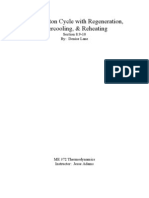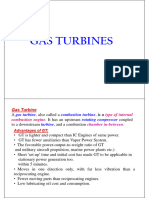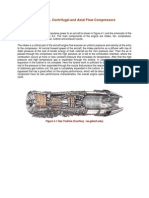Stirling Cycle and The Ericsson Cycle. They Differ From The Carnot Cycle in That The Two
Stirling Cycle and The Ericsson Cycle. They Differ From The Carnot Cycle in That The Two
Uploaded by
annukiitCopyright:
Available Formats
Stirling Cycle and The Ericsson Cycle. They Differ From The Carnot Cycle in That The Two
Stirling Cycle and The Ericsson Cycle. They Differ From The Carnot Cycle in That The Two
Uploaded by
annukiitOriginal Description:
Original Title
Copyright
Available Formats
Share this document
Did you find this document useful?
Is this content inappropriate?
Copyright:
Available Formats
Stirling Cycle and The Ericsson Cycle. They Differ From The Carnot Cycle in That The Two
Stirling Cycle and The Ericsson Cycle. They Differ From The Carnot Cycle in That The Two
Uploaded by
annukiitCopyright:
Available Formats
1- Stirling cycle and the Ericsson cycle.
They differ from the Carnot cycle in that the two
isentropic processes are replaced by two constant-volume regeneration processes in the
Stirling cycle and by two constant-pressure regeneration processes in the Ericsson cycle.
2- All three cycles must have the same thermal efficiency when operating between the same
temperature
limits:
3- The Brayton cycle was first proposed by George Brayton for use in the reciprocating oil-
burning engine that he developed around 1870. Today, it is used for gas turbines only
where both the compression and expansion processes take place in rotating machinery.
Gas turbines usually operate on an open Cycle.
1-2 Isentropic compression (in a compressor)
2-3 Constant-pressure heat addition
3-4 Isentropic expansion (in a turbine)
4-1 Constant-pressure heat rejection
4- The thermal efficiency of an ideal Brayton cycle depends on the pressure ratio of the gas
turbine and the specific heat ratio of the working fluid.
5- For a fixed turbine inlet temperature T3, the net work output per cycle increases with the
pressure ratio, reaches a maximum, and then starts to decrease.
6- In gas-turbine power plants, the ratio of the compressor work to the turbine work, called
the back work ratio, is very high (Fig. 9–34). Usually more than one-half of the turbine
work output is used to drive the compressor. The situation is even worse when the
isentropic efficiencies of the compressor and the turbine are low. This is quite in contrast
to steam power plants, where the back work ratio is only a few percent. This is not
surprising, however, since a liquid is compressed in steam power plants instead of a gas,
and the steady-flow work is proportional to the specific volume of the working fluid. A
power plant with a high back work ratio requires a larger turbine to provide the additional
power requirements of the compressor. Therefore, the turbines used in gas-turbine power
plants are larger than those used in steam power plants of the same net power output.
7- The efforts to improve the cycle efficiency concentrated in three areas:
1. Increasing the turbine inlet (or firing) temperatures
2. Increasing the efficiencies of turbomachinery components
3. Adding modifications to the basic cycle The simple-cycle efficiencies of early gas
turbines were practically doubled by incorporating intercooling,regeneration (or
recuperation), and reheating,
8- The high-pressure air leaving the compressor can be heated by transferring heat to it
from the hot exhaust gases in a counter-flow heat exchanger, which is also known as a
regenerator or a recuperator
jkhkh
You might also like
- LM6000 PC O&M - GEK 105059 CHG 06Document1,988 pagesLM6000 PC O&M - GEK 105059 CHG 06Alejandro J. Vigo50% (2)
- A Case Study On SCADA Implementation in 220 KV SubstationDocument11 pagesA Case Study On SCADA Implementation in 220 KV SubstationAnonymous ggwJDMh8No ratings yet
- Thermodynamics Lecture 6Document32 pagesThermodynamics Lecture 6MarkJude Morla100% (1)
- The Brayton Cycle With RegenerationDocument14 pagesThe Brayton Cycle With RegenerationMuh Indrawan100% (1)
- Brayton Cycle Reheat Regen RecollingDocument14 pagesBrayton Cycle Reheat Regen RecollingDaxit LodaliyaNo ratings yet
- Brayton CycleDocument12 pagesBrayton CycleVinoth KumarNo ratings yet
- Ch2 - Gas TurbinesDocument37 pagesCh2 - Gas TurbinesShaktivell Letchumanan100% (2)
- Chapter 8B - Gas Power Plant Brayton CycleDocument17 pagesChapter 8B - Gas Power Plant Brayton CycleBF3nobel100% (1)
- Gas Turbine MaintenanceDocument146 pagesGas Turbine MaintenanceMamoun1969100% (12)
- Stirling & Ericsson CyclesDocument9 pagesStirling & Ericsson CyclesAntônio GoulartNo ratings yet
- Chapter Five Gas Turbine Power PlantDocument23 pagesChapter Five Gas Turbine Power PlantBese Mat100% (2)
- Gas TurbineDocument25 pagesGas TurbineMohammed AlsirajNo ratings yet
- University of Karbala Department of Mechanical Lecture Notes - Power Plants by Fadhel Al-MousawiDocument27 pagesUniversity of Karbala Department of Mechanical Lecture Notes - Power Plants by Fadhel Al-Mousawiحامد عبد الشهيد حميد مجيد100% (2)
- Gas TurbinesDocument22 pagesGas Turbineswayzodeneeraj100% (1)
- Unit 3 Gas Turbines AND JET PROPULSIONDocument99 pagesUnit 3 Gas Turbines AND JET PROPULSIONSANTHOSH NAGARAJANo ratings yet
- Gas TurbineDocument53 pagesGas Turbinedipakbag100% (1)
- Brayton CycleDocument15 pagesBrayton CycleWahyudin BetaNo ratings yet
- Gas Turbine Power Plant PresentationDocument126 pagesGas Turbine Power Plant Presentationjehadyam100% (5)
- Gas Turbine Power Plant: Fig.1-2: Components of A Basic Gas Turbine EngineDocument22 pagesGas Turbine Power Plant: Fig.1-2: Components of A Basic Gas Turbine Engineام البنين الرياني100% (2)
- Gas Turbine Cycles - LectureDocument18 pagesGas Turbine Cycles - LectureSrinu Reddy100% (2)
- Expt. 02 Stusy of A Gas Turbine Power PlantDocument5 pagesExpt. 02 Stusy of A Gas Turbine Power PlantSajeeb SarkerNo ratings yet
- TurbineDocument9 pagesTurbineKabir Bashir ShariffNo ratings yet
- Gas Power CycleDocument49 pagesGas Power CycleNafisa AnikaNo ratings yet
- 06 Gas Turbine Power PlantDocument31 pages06 Gas Turbine Power PlantRishav niroula100% (1)
- Module 2 Gas Turbines PDFDocument31 pagesModule 2 Gas Turbines PDFafaq ahmad khanNo ratings yet
- Gas Turbine DescriptionDocument8 pagesGas Turbine DescriptionSIVAPATHASEKARANNo ratings yet
- 02gas tURBINES - A PDFDocument38 pages02gas tURBINES - A PDFAdib ShaidanNo ratings yet
- Gas Turbine Working PrincipleDocument7 pagesGas Turbine Working PrincipleAhmed Mohamed SalihNo ratings yet
- Gas Turbine: Olar LoungeDocument34 pagesGas Turbine: Olar Loungepkdevan68100% (1)
- Pplied: ThermodynamicsDocument86 pagesPplied: ThermodynamicsAlaa Shammaa100% (1)
- Chapter 9 LectureDocument29 pagesChapter 9 Lectureinam vf100% (6)
- 8.ME 169-Gas TurbinesDocument21 pages8.ME 169-Gas TurbinesMD MUSTAFANo ratings yet
- Brayton Cycle: The Ideal Cycle For Gas-Turbine Engines in Relation To Power PlantsDocument15 pagesBrayton Cycle: The Ideal Cycle For Gas-Turbine Engines in Relation To Power PlantsmechturboNo ratings yet
- Classification of Gas Turbine Power PlantDocument7 pagesClassification of Gas Turbine Power PlantPK100% (3)
- Air Cycle Refrigeration Systems Gas Turbine CyclesDocument32 pagesAir Cycle Refrigeration Systems Gas Turbine Cyclesswai singhNo ratings yet
- Gas Turbine Power PlantDocument11 pagesGas Turbine Power PlantCK Godinez100% (1)
- Gas Turbine Power PlantDocument20 pagesGas Turbine Power Plantumar100% (1)
- Power Plant: Lec. (7) Dr. Omar M. AliDocument10 pagesPower Plant: Lec. (7) Dr. Omar M. AliBalen KarimNo ratings yet
- Gas Engines, Combined Cycles and TrigenerationDocument9 pagesGas Engines, Combined Cycles and Trigenerationsimon107No ratings yet
- 14 Gas Turbine PlantDocument4 pages14 Gas Turbine PlantAshwini SinghNo ratings yet
- 3 - Gasturbine, Lect 3Document31 pages3 - Gasturbine, Lect 3ahmedmansour.ms66No ratings yet
- Ch-6-W-12-Gas TurbinesDocument50 pagesCh-6-W-12-Gas TurbinesArkew Bogale100% (2)
- What Is An Open Cycle Gas TurbineDocument3 pagesWhat Is An Open Cycle Gas TurbineAmit B MakNo ratings yet
- Exp 4-Gas Turbine AnalysisDocument17 pagesExp 4-Gas Turbine AnalysisEdgar FigueroaNo ratings yet
- Combined Cycle Power PlantDocument11 pagesCombined Cycle Power PlantPGPaloma100% (2)
- Analysis of A Combined Regenerative and Reheat Gas Turbine CycleDocument8 pagesAnalysis of A Combined Regenerative and Reheat Gas Turbine Cyclehumzafarrukh7No ratings yet
- Lec - 7 PP - Gas Turbine PPDocument20 pagesLec - 7 PP - Gas Turbine PPLog XNo ratings yet
- Combined Cycle, Combined Cycle With Heat Recovery..Document4 pagesCombined Cycle, Combined Cycle With Heat Recovery..abdul100% (1)
- Gas Turbine System & PropulsionDocument35 pagesGas Turbine System & PropulsionnaveedsidhuNo ratings yet
- Gas Turbine Jet PropulsionDocument34 pagesGas Turbine Jet PropulsionAányâNo ratings yet
- Introduction To Gas Turbine:: Land Based Gas Turbines Are of Two TypesDocument9 pagesIntroduction To Gas Turbine:: Land Based Gas Turbines Are of Two TypesTahir MuneebNo ratings yet
- Power Point Technology AssignmentDocument5 pagesPower Point Technology AssignmentMusa Maroy StevenNo ratings yet
- Gas Turbine 2Document22 pagesGas Turbine 2Atanda Babatunde MutiuNo ratings yet
- Marvel Carbureter and Heat Control: As Used on Series 691 Nash Sixes Booklet SFrom EverandMarvel Carbureter and Heat Control: As Used on Series 691 Nash Sixes Booklet SNo ratings yet
- Gas-Engines and Producer-Gas Plants A Practice Treatise Setting Forth the Principles of Gas-Engines and Producer Design, the Selection and Installation of an Engine, Conditions of Perfect Operation, Producer-Gas Engines and Their Possibilities, the Care of Gas-Engines and Producer-Gas Plants, with a Chapter on Volatile Hydrocarbon and Oil EnginesFrom EverandGas-Engines and Producer-Gas Plants A Practice Treatise Setting Forth the Principles of Gas-Engines and Producer Design, the Selection and Installation of an Engine, Conditions of Perfect Operation, Producer-Gas Engines and Their Possibilities, the Care of Gas-Engines and Producer-Gas Plants, with a Chapter on Volatile Hydrocarbon and Oil EnginesNo ratings yet
- Share MarketDocument3 pagesShare MarketannukiitNo ratings yet
- Share MarketDocument3 pagesShare MarketannukiitNo ratings yet
- Share MarketDocument3 pagesShare MarketannukiitNo ratings yet
- Share MarketDocument3 pagesShare MarketannukiitNo ratings yet
- Share MarketDocument3 pagesShare MarketannukiitNo ratings yet
- Share MarketDocument3 pagesShare MarketannukiitNo ratings yet
- Share MarketDocument3 pagesShare MarketannukiitNo ratings yet
- Share MarketDocument3 pagesShare MarketannukiitNo ratings yet
- Share MarketDocument3 pagesShare MarketannukiitNo ratings yet
- Share MarketDocument3 pagesShare MarketannukiitNo ratings yet
- Share MarketDocument3 pagesShare MarketannukiitNo ratings yet
- Share MarketDocument3 pagesShare MarketannukiitNo ratings yet
- Share MarketDocument3 pagesShare MarketannukiitNo ratings yet
- Epd FuergyDocument10 pagesEpd FuergyRobert BalazsNo ratings yet
- Compressor Technical DataDocument4 pagesCompressor Technical DataEstebanLiNo ratings yet
- LD1020831 Folleto LedBox LED SPORTS PDFDocument9 pagesLD1020831 Folleto LedBox LED SPORTS PDFAntonio CabreraNo ratings yet
- Tamturbo Product SheetDocument2 pagesTamturbo Product SheetbracioNo ratings yet
- Zhifang MagicPower BrochureDocument13 pagesZhifang MagicPower Brochureshirenwen3No ratings yet
- Ktaa19 G6a enDocument5 pagesKtaa19 G6a enMohamoud MuseNo ratings yet
- Growatt 30000-40000 TL3-SE PDFDocument31 pagesGrowatt 30000-40000 TL3-SE PDFDibyendu MaityNo ratings yet
- Gr2 Wk13 Food Is Our Fuel PDFDocument2 pagesGr2 Wk13 Food Is Our Fuel PDFlouise enriquezNo ratings yet
- T T T T LN T T LMTD: Chapter 18 - Heat PumpsDocument4 pagesT T T T LN T T LMTD: Chapter 18 - Heat PumpsaafgaloNo ratings yet
- SW - SBI - Survey ReportDocument6 pagesSW - SBI - Survey ReportYanto SaputraNo ratings yet
- RM6-en-2004 CatDocument38 pagesRM6-en-2004 Catengnajeeb75No ratings yet
- Each Question Carries Mark 1.: Objective TypeDocument7 pagesEach Question Carries Mark 1.: Objective Typeأبو أسامة حمديNo ratings yet
- 0606 - TD - E2842 LE312 - Nat - EngDocument8 pages0606 - TD - E2842 LE312 - Nat - EngfaridNo ratings yet
- Field ResistanceDocument3 pagesField ResistanceAristotle Geo MandacNo ratings yet
- Toyama Electric ProfileDocument17 pagesToyama Electric Profilesrikant0% (1)
- Megger PCITSDocument3 pagesMegger PCITSelie awadNo ratings yet
- Lux M11 Led 2cilindrosDocument2 pagesLux M11 Led 2cilindrosalmasasrlinformesNo ratings yet
- Blair Air SystemDocument11 pagesBlair Air SystemHIPAPNo ratings yet
- Journal Pipeline Engineering 2013Document76 pagesJournal Pipeline Engineering 2013JAbidMukarrom100% (1)
- Ac, DC, or Ac/Dc Hipot/Megohmmeters: PhenixDocument4 pagesAc, DC, or Ac/Dc Hipot/Megohmmeters: PhenixUlyyszesz AalvaaraadooNo ratings yet
- Term Exam Me2aDocument3 pagesTerm Exam Me2aJonathan Ampis67% (3)
- Digestive Process NotesDocument2 pagesDigestive Process NotesHARSHA LNo ratings yet
- Week 4.1 AdvancedDocument21 pagesWeek 4.1 AdvancedAaron MostNo ratings yet
- Garioni Naval - Heat Industrial and Marine International ConferenceDocument13 pagesGarioni Naval - Heat Industrial and Marine International ConferencegarioninavalNo ratings yet
- A National Vision Smart Grids KoreaDocument10 pagesA National Vision Smart Grids KoreaAlan Edu RojasNo ratings yet
- APTEL Order - Remand Back To RERCDocument10 pagesAPTEL Order - Remand Back To RERCbhupendra barhatNo ratings yet
- New ERA For Electricity in Europe 2003Document29 pagesNew ERA For Electricity in Europe 2003Joan AymerichNo ratings yet
- Design of A Solar PV SystemDocument46 pagesDesign of A Solar PV SystemGokulNo ratings yet






































































































